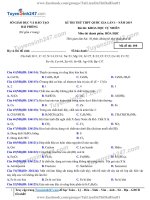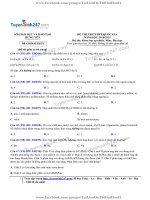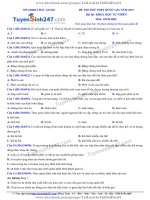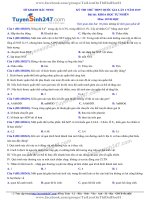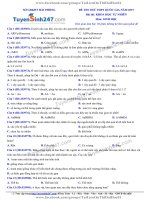- Trang chủ >>
- Sư phạm >>
- Sư phạm tiểu học
Đề thi thử THPT Tiếng anh 2019 sở GD&ĐT Vĩnh Phúc mã đề 202 - Học Toàn Tập
Bạn đang xem bản rút gọn của tài liệu. Xem và tải ngay bản đầy đủ của tài liệu tại đây (146.9 KB, 4 trang )
<span class='text_page_counter'>(1)</span><div class='page_container' data-page=1>
Trang 1/4 - Mã đề thi 202
<b>SỞ GD&ĐT VĨNH PHÚC </b>
<i>(Đề thi có 04 trang) </i>
<b>KỲ KHẢO SÁT KIẾN THỨC THPT LẦN 1 NĂM HỌC 2018-2019 </b>
<b>MÔN: TIẾNG ANH - LỚP 12 </b>
<i>Thời gian làm bài: 60 phút, không kể thời gian giao đề </i>
<b><sub>Mã đề: 202 </sub></b>
<i><b>Mark the letter A, B, C, or D on your answer sheet to indicate the word whose underlined part differs from </b></i>
<i><b>the other three in pronunciation in each of the following questions. </b></i>
<b>Câu 1: </b> <b>A. rehearsal </b> <b>B. history </b> <b>C. honesty </b> <b>D. inhuman </b>
<b>Câu 2: </b> <b>A. instance </b> <b>B. sacrifice </b> <b>C. contractual </b> <b>D. applicant </b>
<i><b>Mark the letter A, B, C, or D on your answer sheet to indicate the word that differs from the other three in </b></i>
<i><b>the position of primary stress in each of the following questions. </b></i>
<b>Câu 3: </b> <b>A. summary </b> <b>B. convention </b> <b>C. impression </b> <b>D. official </b>
<b>Câu 4: </b> <b>A. compare </b> <b>B. consume </b> <b>C. traffic </b> <b>D. affect </b>
<i><b>Mark the letter A, B, C, or D on your answer sheet to indicate the underlined part that needs correction in </b></i>
<i><b>each of the following questions. </b></i>
<b>Câu 5: Major advertising companies have traditionally volunteered its time to public service accounts. </b>
<b>A. its </b> <b>B. advertising </b> <b>C. traditionally </b> <b>D. to public </b>
<b>Câu 6: The majority of people in the music industry work behind the scenes, but the roles they play in the </b>
musical process is very important.
<b>A. behind </b> <b>B. is </b> <b>C. majority </b> <b>D. play </b>
<b>Câu 7: Ms. Parker has improved a great deal in terms of her dress code, attitude, and she goes to work on time. </b>
<b>A. has improved </b> <b>B. she goes to work on time </b>
<b>C. in terms of </b> <b>D. attitude </b>
<i><b>Mark the letter A, B, C, or D on your answer sheet to indicate the correct answer to each of the following </b></i>
<i><b>questions. </b></i>
<b>Câu 8: This company is very ______ about who it employs. </b>
<b>A. selective </b> <b>B. selection </b> <b>C. select </b> <b>D. selectively </b>
<b>Câu 9: If Mr. Dewey ______ present at the conference, he would have offered any possible assistance to the </b>
people there.
<b>A. was </b> <b>B. had been </b> <b>C. should be </b> <b>D. were </b>
<b>Câu 10: I really regret making my mistake. It was the one I ______. </b>
<b>A. ought not to have made </b> <b>B. wouldn’t have made </b>
<b>C. can’t have made </b> <b>D. mustn’t have made </b>
<b>Câu 11: You wouldn’t consider _____ a man for his money, then? </b>
<b>A. married </b> <b>B. marry </b> <b>C. marrying </b> <b>D. to marry </b>
<b>Câu 12: Go straight into the cave and find out what’s in there, ______? </b>
<b>A. do you </b> <b>B. can you </b> <b>C. don’t you </b> <b>D. will you </b>
<b>Câu 13: An example of a(n) ______ item is a shirt made of low-grade cotton, allowing it to be sold for a very low </b>
price.
<b>A. downmarket </b> <b>B. up-to-the-minute </b> <b>C. down to earth </b> <b>D. up-to-date </b>
<b>Câu 14: Free medical treatment in this country covers sickness of mind as well as ______ sickness. </b>
<b>A. average </b> <b>B. formal </b> <b>C. regular </b> <b>D. ordinary </b>
<b>Câu 15: He was a natural singer with a voice that was as clear as ______. </b>
<b>A. a waterfall </b> <b>B. a mirror </b> <b>C. a bell </b> <b>D. a lake </b>
<b>Câu 16: The press accused the Ministry of Health of either being unaware of the measles epidemic or ______ a </b>
blind eye to it.
<b>A. turning </b> <b>B. making </b> <b>C. taking </b> <b>D. doing </b>
<b>Câu 17: The store had to ______ a number of clerks because sales were down. </b>
<b>A. lay off </b> <b>B. lay out </b> <b>C. lay aside </b> <b>D. lay down </b>
<b>Câu 18: The assistant director recommended that Kenichi ______ to the New York office. </b>
<b>A. is tranferred </b> <b>B. tranferring </b> <b>C. to transfer </b> <b>D. be tranferred </b>
<b>Câu 19: Please don’t tell me what happens in the end because I ______ the book yet. </b>
<b>A. haven’t read </b> <b>B. haven’t been reading </b> <b>C. am not reading </b> <b>D. don’t read </b>
<i><b>Mark the letter A, B, C, or D on your answer sheet to indicate the most suitable response to complete each of </b></i>
<i><b>the following exchanges. </b></i>
</div>
<span class='text_page_counter'>(2)</span><div class='page_container' data-page=2>
Trang 2/4 - Mã đề thi 202
<b>A. I am sorry to hear that </b> <b>B. That’s fine </b>
<b>C. I am afraid so </b> <b>D. That’s all right </b>
<b>Câu 21: – John: “Why are the renovations being delayed?” </b> <b>– David: “______.” </b>
<b>A. Yes, but it should be changed </b> <b>B. The building really needs renovating </b>
<b>C. We must get a permit first </b> <b>D. It was delayed over two hours </b>
<i><b>Mark the letter A, B, C, or D on your answer sheet to indicate the word(s) CLOSEST in meaning to the </b></i>
<i><b>underlined word(s) in each of the following questions. </b></i>
<b>Câu 22: Supporters of euthanasia maintain that it is a humane act aimed at preventing a patient from further </b>
suffering.
<b>A. handling with care </b> <b>B. treating with cruelty </b>
<b>C. causing little suffering </b> <b>D. making peace </b>
<b>Câu 23: If I say something odd, it’s because I didn’t sleep at all last night. When I get extremely tired, I can </b>
sometimes get a bit weird.
<b>A. be too clever </b> <b>B. not be able to concentrate </b>
<b>C. not be able to participate </b> <b>D. act strangely or unusually </b>
<i><b>Mark the letter A, B, C, or D on your answer sheet to indicate the word(s) OPPOSITE in meaning to the </b></i>
<i><b>underlined word(s) in each of the following questions. </b></i>
<b>Câu 24: It is extremely hard for certain computer technology to stay state-of-the-art for a long time as new </b>
technologies are invented almost every day.
<b>A. up to date </b> <b>B. in due time </b> <b>C. behind the times </b> <b>D. in the wind </b>
<b>Câu 25: Many people are prone to colds in winter, so they take extra precautions to remain in good health. </b>
<b>A. allergic to </b> <b>B. likely to get </b> <b>C. usually addicted to </b> <b>D. protected from </b>
<i><b>Mark the letter A, B, C, or D on your answer sheet to indicate the sentence that is closest in meaning to each </b></i>
<i><b>of the following questions. </b></i>
<b>Câu 26: It is said that in some cultures and religions, recreation is encouraged on certain days. </b>
<b>A. Recreation is said in some cultures and religions that it is encouraged on certain days. </b>
<b>B. Some cultures and religions are said to be encouraged on certain days. </b>
<b>C. Recreation is said to be encouraged on certain days in some cultures and religions. </b>
<b>D. It is recreation that encouraged on certain days in some cultures and religions. </b>
<b>Câu 27: “Why don’t you put a better lock on the door, John?” Mary said. </b>
<b>A. Mary suggested that John should put a better lock on the door. </b>
<b>B. Mary told John not to put a better lock on the door. </b>
<b>C. John promised to put a better lock on the door. </b>
<b>D. Mary complained to John about the lock on the door. </b>
<b>Câu 28: As soon as he arrived at the airport, he called home. </b>
<b>A. He arrived at the airport and called me to take him home. </b>
<b>B. Calling home, he said that he had arrived at the airport. </b>
<b>C. No sooner had he called home than he arrived at the airport. </b>
<b>D. Scarcely had he arrived at the airport when he called home. </b>
<i><b>Mark the letter A, B, C, or D on your answer sheet to indicate the sentence that best combines each pair of </b></i>
<i><b>sentences in the following questions. </b></i>
<b>Câu 29: We had overslept. We missed the bus. </b>
<b>A. If we hadn’t overslept, we wouldn’t miss the bus. </b>
<b>B. Having overslept so we couldn’t catch the bus. </b>
<b>C. Though we had overslept, we wouldn’t miss the bus. </b>
<b>D. As a result of having overslept, we couldn’t catch the bus. </b>
<b>Câu 30: She heard the news about her friend’s death. She broke down. </b>
<b>A. Heard the news about her friend’s death, she broke down. </b>
<b>B. Having heard the news about her friend’s death, she broke down. </b>
<b>C. She broke down while she was hearing the news about her friend’s death. </b>
<b>D. She heard the news about her friend’s death the moment she broke down. </b>
<i><b>Read the following passage and mark the letter A, B, C, or D on your answer sheet to indicate the correct </b></i>
<i><b>word or phrase that best fits each of the numbered blanks from 31 to 35. </b></i>
In 2000, Honda created (31) ______ walking robot after two decades of developing humanoid robots.
Currently, it is displayed in Miraikan museum in the Japanese capital city of Tokyo.
</div>
<span class='text_page_counter'>(3)</span><div class='page_container' data-page=3>
Trang 3/4 - Mã đề thi 202
out various complicated jobs. His latest challenge has been to direct the (33) ______ of a full orchestra in a
performance of the tune ‘The Impossible Dream’.
Using both hands, Asimo led the musicians confidently and managed to make them slow down for a strong
finish. He ended the piece (34) ______ a powerful, long note before turning to the audience. Asimo’s realistic
movements were based on those of the orchestra’s director, who had filmed himself playing the same piece six
months previously. Asimo was then ‘taught’ by his programmers to copy the movements on the film.
(35) ______, Asimo’s battery runs out after 20 minutes, so the orchestra’s regular director need not worry
about Asimo taking over his job!
<b>Câu 31: </b> <b>A. an </b> <b>B. a </b> <b>C. Ø </b> <b>D. the </b>
<b>Câu 32: </b> <b>A. whose </b> <b>B. which </b> <b>C. who </b> <b>D. that </b>
<b>Câu 33: </b> <b>A. members </b> <b>B. employees </b> <b>C. staff </b> <b>D. people </b>
<b>Câu 34: </b> <b>A. up </b> <b>B. by </b> <b>C. for </b> <b>D. with </b>
<b>Câu 35: </b> <b>A. Furthermore </b> <b>B. Therefore </b> <b>C. For example </b> <b>D. Fortunately </b>
<i><b>Read the following passage and mark the letter A, B, C, or D on your answer sheet to indicate the correct </b></i>
<i><b>answer to each of the questions from 36 to 42. </b></i>
The human criterion for perfect vision is 20/20 for reading the standard lines on a Snellen eye chart
<b>without a hitch. The score is determined by how well you read lines of letters of different sizes from 20 feet </b>
away. But being able to read the bottom line on the eye chart does not approximate perfection as far as other
species are concerned. Most birds would consider us very visually handicapped. The hawk, for instance, has such
sharp eyes that it can spot a dime on the sidewalk while perched on top of the Empire State Building. It can make
fine visual distinctions because it is blessed with one million cones per square millimeter in its retina. And in
water, humans are farsighted, while the kingfisher, swooping down to spear fish, can see well in both the air and
water because it is endowed with two foveae – areas of the eye, consisting mostly of cones, that provide visual
distinctions. One foveae permits the bird, while in the air, to scan the water below with one eye at a time. This is
called monocular vision. Once it hits the water, the other fovea joins in, allowing the kingfisher to focus both
eyes, like binoculars, on its prey at the same time. A frog’s vision is distinguished by its ability to perceive things
as a constant motion picture. Known as “bug detectors”, a highly developed set of cells in a frog’s eyes responds
mainly to moving objects. So, it is said that a frog sitting in a field of dead bugs wouldn’t see them as food and
would starve.
The bee has a “compound” eye, which is used for navigation. It has 15,000 facets that divide what it sees
into a pattern of dots, or mosaic. With this kind of vision, the bee sees the sun only as a single dot, a constant
point of reference. Thus, the eye is a superb navigational instrument that constantly measures the angle of its line
of flight in relation to the sun. A bee’s eye also gauges flight speed. And if that is not enough to leave our 20/20
“perfect vision” paling into insignificance, the bee is capable of seeing something we can’t – ultraviolet light.
Thus, what humans consider to be “perfect vision” is in fact rather limited when we look at other species.
However, there is still much to be said for the human eye. Of all the mammals, only humans and some primates
can enjoy the pleasures of color vision.
<b>Câu 36: What does the passage mainly discuss? </b>
<b>A. Limits of the human eye </b> <b>B. Eye variation among different species </b>
<b>C. Different eyes for different uses </b> <b>D. Perfect vision </b>
<b>Câu 37: The phrase “without a hitch” in paragraph 1 is closest in meaning to ______. </b>
<b>A. unaided </b> <b>B. with little hesitation </b> <b>C. easily </b> <b>D. without glasses </b>
<b>Câu 38: According to the passage, why might birds and animals consider humans very visually handicapped? </b>
<b>A. Human eyes are not as well suited to our needs. </b>
<b>B. Human eyes can’t do what their eyes can do. </b>
<b>C. The main outstanding feature of human eyes is color vision. </b>
<b>D. Humans can’t see very well in either air or water. </b>
<b>Câu 39: The word “that” in paragraph 1 refers to ______. </b>
<b>A. cones </b> <b>B. foveae </b> <b>C. air and water </b> <b>D. visual distinctions </b>
<b>Câu 40: According to the passage, “bug detectors” are useful for ______. </b>
<b>A. avoiding starvation </b> <b>B. seeing moving objects </b>
<b>C. avoiding bugs when getting food </b> <b>D. navigation </b>
<b>Câu 41: According to the passage, which of the following is NOT true? </b>
<b>A. Bees see patterns of dots. </b>
<b>B. Hawks eyes consist mostly of cones that can allow it to scan with one eye at a time. </b>
<b>C. Kingfishers have monocular vision. </b>
</div>
<span class='text_page_counter'>(4)</span><div class='page_container' data-page=4>
Trang 4/4 - Mã đề thi 202
<b>Câu 42: Which of the following can be inferred from the passage? </b>
<b>A. Bees have the most complex eye. </b>
<b>B. Eyes have developed differently in each species. </b>
<b>C. Humans should not envy what they don’t need. </b>
<b>D. Perfect vision is not perfect. </b>
<i><b>Read the following passage and mark the letter A, B, C, or D on your answer sheet to indicate the correct </b></i>
<i><b>answer to each of the questions from 43 to 50. </b></i>
In modern times, we seem to be getting more separate from nature with each passing day. Most of us spend the
majority of our time indoors, typing away at computers and fiddling with digital devices. All the while, we are
destroying the planet’s natural beauty by cutting down forests and building cities in their place. In an effort to
preserve nature for future generations, national parks were created.
The primary function of national parks is conservation. In many cases, it is a matter of national pride for
countries to protect their indigenous species. Although several nations considered opening national parks, the US
was the first country to officially do so when Yellowstone Park opened in 1872. This designation made the federal
government responsible for taking care of the territory. Soon after, national parks started to open in Australia,
New Zealand, Europe, and eventually across the globe. Today, almost 100 countries have established their own
national parks. In total, there are over 6,500 worldwide.
There are several incredible national parks that have a lot to offer. Kruger National Park in South Africa at
19,633 square kilometers is one of the largest game reserves. Tourists can go on safari and witness elephants,
rhinoceroses, lions, and several other large mammals in their natural environments. At 75,000 square miles, the
Northeast Greenland National Park is the world’s largest. In fact, it is larger than all but 30 countries in the world.
Despite differences in names, location, and rules, most natural parks have certain traits in common. For one,
they are usually open to visitors throughout the year. Those who come to the park can take part in a wide scope of
outdoor activities including hiking, camping, cycling, bird watching, and fishing. Other options may include
horseback riding, rafting, or scuba diving if the territory is suitable. In most places, visitors are encouraged not to
feed the animals. The purpose for this law is twofold: to protect the animals as well as those who might feed them.
Animals also have strict dietary needs, so feeding them exotic foods could make them sick. Feeding wild animals
could also cause them to aggressively pester humans they encounter in the future for food. However, as long as
you follow the rules, you are assured of having a great time at whichever national park you visit.
<b>Câu 43: What does the first paragraph mainly talk about? </b>
<b>A. Some reasons why national parks are necessary </b>
<b>B. A few things you will likely see if you go to visit a national park </b>
<b>C. How national parks will probably be different in the future </b>
<b>D. What people will likely see when they visit a national park </b>
<b>Câu 44: The word “indigenous” in paragraph 2 is closest in meaning to ______. </b>
<b>A. rare </b> <b>B. large </b> <b>C. extinct </b> <b>D. native </b>
<b>Câu 45: Which of the following people would probably be most interested in visiting Kruger National Park? </b>
<b>A. Someone who is interested in rare plants </b> <b>B. Someone who is interested in hiking </b>
<b>C. Someone who needs to adopt an animal </b> <b>D. Someone who likes observing large creatures </b>
<b>Câu 46: Which of these activities would probably NOT be featured at a national park? </b>
<b>A. Mountain climbing </b> <b>B. Canoeing </b> <b>C. Rafting </b> <b>D. Flying lessons </b>
<b>Câu 47: Which of the following is NOT true about national parks? </b>
<b>A. There are rules against feeding animals by tourists. </b>
<b>B. They have been established to avoid disasters. </b>
<b>C. They offer a variety of activities to visitors. </b>
<b>D. They lies at locations with different traits. </b>
<b>Câu 48: The word “exotic” in the last paragraph is closest in meaning to ______. </b>
<b>A. frozen </b> <b>B. health </b> <b>C. unusual </b> <b>D. funtional </b>
<b>Câu 49: The word “they” in the last paragraph refers to ______. </b>
<b>A. visitors </b> <b>B. guards </b> <b>C. animals </b> <b>D. exotic foods </b>
<b>Câu 50: What can be inferred from the passage? </b>
<b>A. The Northeast Greenland National Park is only smaller than 30 countries in the world. </b>
<b>B. National parks are not open to visitors in winter. </b>
<b>C. National parks in the US are under the control of the state authorities. </b>
<b>D. National parks were established in Britain earlier than those in the US. </b>
---
--- HẾT ---
</div>
<!--links-->



